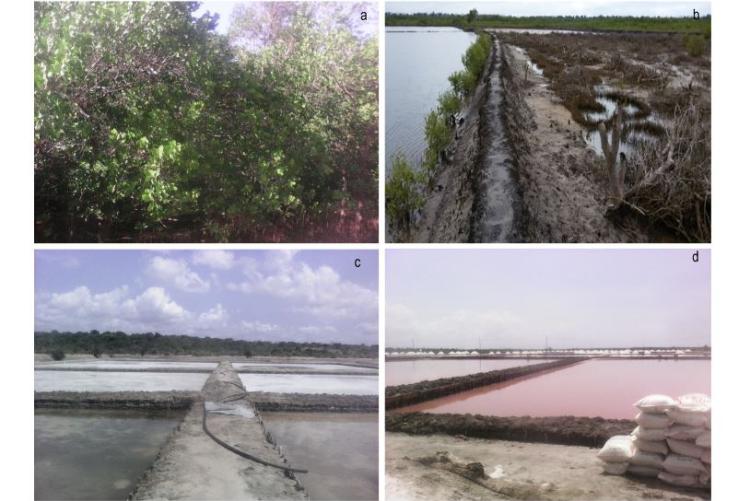Solar salt production in mangroves is among the potential causes of disturbance, which modify habitats along the east African coast as it involves clearing and selective logging of mangroves, which alter microhabitats and microclimates.
The impacts of solar salt ponds on mangrove ecosystems have not received serious attention so far and this has resulted in the ongoing loss of mangroves in many areas, especially in developing countries.

Mangroves and salt ponds in Tanzania, Western Indian Ocean. a. Natural mangrove; b. a newly cleared mangrove to extend salt ponds; c. an old active salt pond with few scattered mangrove trees behind; d. a salt pond during the harvesting time; with dykes enclosing the ponds in b, c and d
Production of salt in mangroves in many areas is also not sustainable, because some of the owners of the salt ponds and local communities are not aware of the possible negative impacts of solar salt farming and the implications of their investments for the integrity of the mangrove ecosystem. Also, little efforts have been made to restore the abandoned salt ponds area and sites where mangroves are cleared and selectively logged.
Recently, researchers from Sokoine University of Agriculture (Department of Biosciences) in Tanzania and Vrije Universiteit Brussel in Belgium conducted a research study to assess the Ecological impact of salt farming on the habitat and food sources of macroinvertebrates. This study took place in mangroves along the coast of Tanzania where loss of mangroves continues due to salt farming.
The general objective of this study was to determine the effects of mangrove deforestation by salt farming activities on the carbon and nitrogen food source availability and utilisation by macroinvertebrates. More specifically they intended to assess if the OM content in sediments, an important potential food source for local invertebrates, is influenced by salt farming activities and correlates with changes in sediment particle size distribution.
They also wanted to determine whether the primary sources of carbon and nitrogen for macroinvertebrates have changed under the influence of salt pond activities. To achieve this, they determined δ13C and δ15N in mangrove leaves, and tissues of macroinvertebrates. The sediment particles size, organic C and total N content as well as δ13C and δ15N composition in sediments were also determined.
They then compared the values obtained from mangroves around the salt ponds and natural mangroves.
The findings of this study have been published in the prestigious journal of sea research indicating that salt pond activities have contributed to the modification of the habitats of macroinvertebrates by causing alteration of sediment characteristics and stable isotopes enrichment in the ecosystem.
Read full article here: https://www.sciencedirect.com/science/article/abs/pii/S1385110117303386




